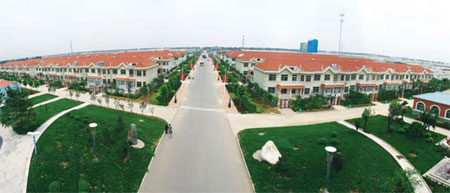|
|

Sanyuanzhu village is a demonstration village for Weifang's "new countryside", a key part of ongoing government efforts to promote urbanization. Provided to China Daily |
Sustainable, people-oriented urbanization is the key to economic success, said a senior official of Weifang, Shandong province.
If done correctly, urbanization can be "a major engine for the sustained, healthy development of the local economy", Weifang Mayor Liu Shuguang said at the National People's Congress and the Chinese People's Political Consultative Conference meetings which opened in Beijing earlier this month.
"We are making greater efforts to boost the quality of urbanization by balancing the development of urban and rural areas and enhancing urban-rural integration of public services and infrastructure," Liu said.
Official statistics show that the city's urbanization rate, the ratio of urban residents to the total population, had reached to 49.7 percent by the end of 2012, a year-on-year increase of 1.8 percentage points.
A total of 12 billion yuan ($1.93 billion) has been allocated for improving the construction of the city's towns and rural areas last year, of which 4 billion yuan was spent on infrastructure and public service facilities.
"We will actively and prudently move forward with urbanization and construction of a new countryside," said Liu, noting that the fundamental goal is to make people happier rather than to merely aim for a high urbanization rate.
As of the end of last year, 6,190 administrative villages in the city have been integrated into 972 new rural communities, and 8,600 dilapidated farmhouses have been repaired, greatly improving the quality of life for rural residents.
The net income of country dwellers topped 12,000 yuan last year, up by 15.8 percent from the previous year, while the per capita disposable income of the urban residents stood at more than 26,000 yuan, up by 15.6 percent.
The city also helped 123,000 rural laborers find jobs in the city center and offered 121,000 new vacancies to urban residents.
Because urbanization draws a large number of rural laborers to work in the city, the key task is how to help these migrants make the transition to becoming urban citizens, Liu said.
To this end, the city is speeding up reforms to the household registration system, which will allow more migrant workers to enjoy the benefits of the urban public service network in terms of housing, employment, education and medical care.
"The migrant workers also have the right to share the fruits of economic growth and should be treated as equals to city dwellers," said Liu.
Balanced development
Meanwhile, Weifang is attaching great importance to the simultaneous development of industrialization, urbanization and agricultural modernization.
Last year, the city's GDP realized a year-on-year increase of 10.6 percent to 401.6 billion yuan, over 80 percent of which is generated by its small towns and county-level cities.
The city is now home to nearly 4,300 industrial enterprises above the designated size, the gross output value of which amounted to more than 1.07 trillion yuan in 2012, up by 14.5 percent.
A total of 11 key industrial zones have been established that focus on such economic pillars as machine manufacturing, advanced materials, electronic information as well as medicine, textiles, clothing and food. Together they are capable of providing jobs for more than 100,000 laborers from the city's rural areas annually.
Liu said the local government also endeavors to improve farm mechanization and modernize agriculture because "urbanization and agricultural modernization are complementary to each other".
Last year alone, 345 modern agricultural demonstration parks and 2,326 new farmer cooperatives opened in the city, enhancing its agricultural labor productivity to 11,000 yuan, which is 3,000 yuan higher than the nation's average level.
Environmental protection will not be ignored during the process of urbanization either, Liu said. The city had built 55 sewage treatment facilities by the end of last year that can handle 95 percent of the sewage produced in urban areas. Its forest area has increased to 35.2 percent of the total and all 23 major rivers under the city's control were able to sustain fish.
Weifang's city government will strive to push its urbanization rate to 56 percent and the urban residents are expected to increase by 700,000 by 2015. It will also try to cultivate five provincial-level model towns for promoting sound urbanization and 19 towns that each is projected to generate local tax and fee revenue surpassing 100 million yuan.
Contact the writers at juchuanjiang@chinadaily.com.cn and wangqian2@chinadaily.com.cn
|